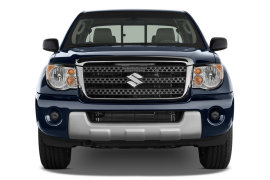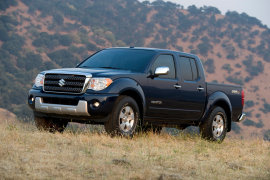SUZUKI Equator Models/Series Timeline, Specifications & Photos
First production year: 2009
Engines: Gasoline
Body style: Truck
Suzuki tried to step up its game and sell more vehicles on the North American market and signed a deal with Nissan for a badge-engineered product: the Equator.
Nissan produced the Equator Extended cab on its assembly lines, and it was actually a badge-engineered product with the Nissan Frontier. But the timing was very bad since the U.S. market was still trying to recover from the world financial crisis that started in 2007. But Suzuki promised the vehicle at the 2008 Chicago Auto Show, and it had to deliver.
Unlike other badge-engineered products, the Suzuki Equator showed a completely different styling at the front than its Nissan Frontier sibling. It featured a massive grille surrounded by a chromed trim. The headlights sported a unique design with two inner amber lights and one outer one flanking the round main headlamp. Depending on the trim level, the front bumper was adorned by a metallic-looking shield underneath. The Extended Cab version featured a pair of doors and a set of windows behind them.
Inside, the Extended Cab version offered room for four passengers, with two front bucket seats at the front and a pair of flip-up rear seats in the rear. Underneath the folding ones, the carmaker installed a storage box. The dashboard was clearly carried over from Nissan, with the same layout that sported a four-gauge setup and two LCDs placed inside the tachometer and speedometer dials. On the center stack, the carmaker added a Bluetooth-compatible stereo.
Under the hood, the pickup was offered with a choice of two engines: a fuel-efficient inline-four and a powerful 4.0-liter V6. The former was available with a five-speed manual, while the latter was mated exclusively with a five-speed automatic. Both versions were provided either with rear- or all-wheel drive systems, with a rear locking differential and a two-speed transfer case.
Suzuki introduced the Equator in the light pick-up market in 2009 as a badge-engineered Nissan Frontier.
Suzuki produced a wide variety of off-road bikes and ATVs, but not a single vehicle to carry them to the "playground" and back. While creating a new vehicle wouldn't make sense for them, they asked their neighbors from Nissan if they could make one for them. And this is how the Equator was born.
From the aesthetic point of view, the Equator featured a completely different front fascia than the Frontier. A wider and taller grille at the front and a different pair of headlights were the main difference apart from the S-badge. From the sides, the Frontier and the Equator looked the same, with the rear doors' raised beltline. The bed in the back was not long enough to carry a dirt-bike with the tailgate closed, but Suzuki installed a cage to keep the motorbike in place.
Inside, the Equator came equipped with SUV-like features such as automatic climate control, leather heated seats, and a navigation system. It could be fitted with a rear-view camera as well. The Suzuki steering wheel was the main difference between the two vehicles.
Under the hood, Nissan installed two engine choices for the Equator. The base version featured a four-pot, 2.5-liter engine, while a 4.0-liter V6 unit powered the top version.

